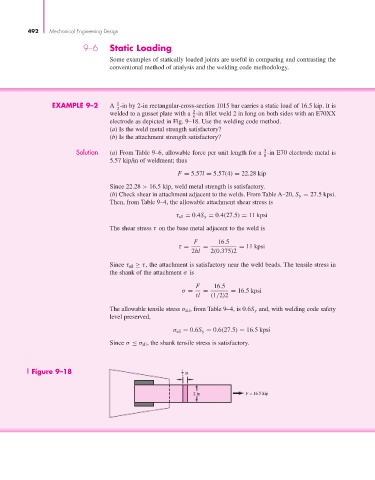Page 518 - Shigley's Mechanical Engineering Design
P. 518
bud29281_ch09_475-516.qxd 12/16/2009 7:12 pm Page 492 pinnacle 203:MHDQ196:bud29281:0073529281:bud29281_pagefiles:
492 Mechanical Engineering Design
9–6 Static Loading
Some examples of statically loaded joints are useful in comparing and contrasting the
conventional method of analysis and the welding code methodology.
1
EXAMPLE 9–2 A -in by 2-in rectangular-cross-section 1015 bar carries a static load of 16.5 kip. It is
2
3
welded to a gusset plate with a -in fillet weld 2 in long on both sides with an E70XX
8
electrode as depicted in Fig. 9–18. Use the welding code method.
(a) Is the weld metal strength satisfactory?
(b) Is the attachment strength satisfactory?
Solution (a) From Table 9–6, allowable force per unit length for a -in E70 electrode metal is
3
8
5.57 kip/in of weldment; thus
F = 5.57l = 5.57(4) = 22.28 kip
Since 22.28 > 16.5 kip, weld metal strength is satisfactory.
(b) Check shear in attachment adjacent to the welds. From Table A–20, S y = 27.5 kpsi.
Then, from Table 9–4, the allowable attachment shear stress is
τ all = 0.4S y = 0.4(27.5) = 11 kpsi
The shear stress τ on the base metal adjacent to the weld is
F 16.5
τ = = = 11 kpsi
2hl 2(0.375)2
Since τ all ≥ τ, the attachment is satisfactory near the weld beads. The tensile stress in
the shank of the attachment σ is
F 16.5
σ = = = 16.5 kpsi
tl (1/2)2
The allowable tensile stress σ all , from Table 9–4, is 0.6S y and, with welding code safety
level preserved,
σ all = 0.6S y = 0.6(27.5) = 16.5 kpsi
Since σ ≤ σ all , the shank tensile stress is satisfactory.
Figure 9–18 1 in
2
2 in F = 16.5 kip

